A standing wave propagating with velocity 300ms−1 in an open pipe of length 4 m has four nodes. The frequency of the wave is
75 Hz
100 Hz
150 Hz
300 Hz
The correct Answer is:C
To find the frequency of the standing wave in the open pipe, we can follow these steps:
Step 1: Understand the relationship between nodes and antinodes in a standing wave.
In an open pipe, the standing wave pattern consists of nodes and antinodes. The number of nodes (N) is related to the number of antinodes (A) by the formula:
A=N−1
For 4 nodes, the number of antinodes will be:
A=4−1=3
Step 2: Determine the wavelength (λ).
The length of the pipe (L) is related to the wavelength (λ) by the formula:
L=n2λ
where n is the number of segments (which is equal to the number of antinodes). Since we have 3 antinodes:
L=32λ
Given that the length of the pipe (L) is 4 m, we can rearrange the equation to find λ:
4=32λ
Multiplying both sides by 23:
λ=4×23=83 m
Step 3: Use the wave velocity to find the frequency (f).
The relationship between wave velocity (v), frequency (f), and wavelength (λ) is given by:
v=fλ
We can rearrange this to solve for frequency:
f=vλ
Substituting the given velocity (v = 300 m/s) and the calculated wavelength (λ = 83 m):
f=30083=300×38=9008=112.5 Hz
Step 4: Final answer.
Thus, the frequency of the wave is:
f=112.5 Hz
In an open pipe, the standing wave pattern consists of nodes and antinodes. The number of nodes (N) is related to the number of antinodes (A) by the formula:
A=N−1
For 4 nodes, the number of antinodes will be:
A=4−1=3
The length of the pipe (L) is related to the wavelength (λ) by the formula:
L=n2λ
where n is the number of segments (which is equal to the number of antinodes). Since we have 3 antinodes:
L=32λ
Given that the length of the pipe (L) is 4 m, we can rearrange the equation to find λ:
4=32λ
Multiplying both sides by 23:
λ=4×23=83 m
The relationship between wave velocity (v), frequency (f), and wavelength (λ) is given by:
v=fλ
We can rearrange this to solve for frequency:
f=vλ
Substituting the given velocity (v = 300 m/s) and the calculated wavelength (λ = 83 m):
f=30083=300×38=9008=112.5 Hz
Thus, the frequency of the wave is:
f=112.5 Hz
Topper's Solved these Questions
Similar Questions
The standing wave pattern shown in the tube has a wave speed of 5.0ms−1. What is the frequency of the standing wave [ in Hz approx.] ?

View SolutionStanding waves are producedin a rubber tube 12m long . If the tube vibrates in five segmens and the velocity of the wave is 480m/s, what is (a) the wave length of the waves (b) the frequency of the wave ?
View Solution
Knowledge Check
Consider the propagating sound (with velocity 330ms−1) in a pipe of length 1.5 m with one end closed and the other open. The frequency associated with the fundamental mode is
A11 HzB55 HzC110 HzD165 HzA string fixed at both the ends forms standing waves with node separation of 5 cm. If the velocity of waves travelling in the string is 4 m/s, then the frequency of vibration of the string will be
A20 HzB30 HzC40 HzD50 Hz
A standing wave in second overtone is maintained in a open pipe of length l. The distance between consecutive displacement node and pressure node is……………
View SolutionThe distance between any two successive antinodes or nodes of a stationary wave is 0.75 m . If the velocity of the wave is 300ms−1 , find the frequency of the wave .
View SolutionA body is vibrating 6000 times in 1 min. If the velocity of sound in air is 300 m s−1, find the frequency of the wave.
View SolutionA sound wave travelling in air is made to propagate through a liquid such that the velocity of sound is quadrupled. If the frequency of the sound wave is constant, find the change in the wavelength of the sound wave
View SolutionA sound wave travelling in air is made to propagate through a liquid such that the velocity of sound is quadrupled. If the frequency of the sound wave is constant, find the change in the wavelength of the sound wave
View SolutionThe wavelength of a sound wave travelling in a solid becomes one third when it propagates through air. If the frequency of the wave remains constant, then find the decreases in the velocity of the wave
View Solution
